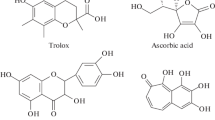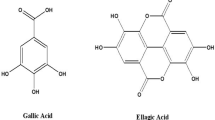Abstract
Plant polyphenols are known to possess antioxidant acitivities. In recent years, there have been numerous reports confirming the efficacy of these compounds to improve plasma antioxidant capacity in humans. Current methods to evaluate the antioxidant potential of polyphenols are based on in vitro assay procedures (TEAC, ORAC, FRAP, DPPH). However, the antioxidant potential assessed by these methods does not correlate with the biological activity observed in vivo. Eukaryotic cells display a plasma membrane redox system (PMRS) that transfers electrons from intracellular substrates to extracellular electron acceptors. Here, we describe a method to evaluate the antioxidant potential of plant polyphenols based on their ability to enter the erythrocytes and donate electrons to PMRS. We also present results to show the potentiating effect of quercetin, EGCG, EC and catechin on erythrocyte PMRS activity.
Access this chapter
Tax calculation will be finalised at checkout
Purchases are for personal use only
Similar content being viewed by others
References
Scalbert A, Manach C, Morand C, Remesy C (2005) Dietary polyphenols and the prevention of diseases. Crit Rev Food Sci Nutr 45:287–306
Leenen R, Roodenburg AJ, Tijburg LB, Wiseman SA (2000) A single dose of tea with or without milk increases plasma antioxidant activity in humans. Eur J Clin Nutr 54:87–92
Fuhrman B, Lavy A, Aviram M (1995) Consumption of red wine with meals reduces the susceptibility of human plasma and low-density lipoprotein to lipid peroxidation. Am J Clin Nutr 61:549–554
Maxwell S, Cruickshank A, Thorpe G (1994) Red wine and antioxidant activity in serum. Lancet 344:193–194
Rice-Evans C, Miller NJ (1994) Total antioxidant status in plasma and body fluids. Methods Enzymol 234:279–293
Cao G, Russell RM, Lischner M, Prior RL (1998) Serum antioxidant capacity is increased by consumption of strawberries, spinach, red wine or vitamin C in elderly women. J Nutr 128:2383–2390
Ghiselli A, Serafini M, Maiani G, Aazzini E, Ferro-Luzzi A (1995) A fluroresence-based method for measuring total plasma antioxidant capacity. Free Radic Biol Med 18:29–36
Benzie IF, Strain JJ (1996) The ferric reducing ability of plasma (FRAP) as a measure of “antioxidant power”: the FRAP assay. Anal Biochem 239:70–76
Ratty AK, Sunamoto J, Das NP (1988) Interaction of flavonoids with 1, 1-diphenyl 2-picrylhydrazyl free radical, liposomal membranes and soybean lipoxygenase-1. Biochem Pharmacol 37:989–995
Rice-Evans CA, Miller NJ, Bolwell PG, Bramley PM, Pridham JB (1995) The relative antioxidant activities of plant-derived polyphenolic flavonoids. Free Radical Res 22:375–383
Guo C, Cao G, Sofic E, Prior RL (1997) High-performance liquid chromatography coupled with coulomertic array detection of electro active components in fruits and vegetables: relationship to oxygen radical absorbance capacity. J Agric Food Chem 45:1787–1796
May JM, Qu ZC (1999) Ascorbate-dependent electron transfer across the human erythrocyte membrane. Biochem Biophys Acta 1421:19–31
Crane FI, Low H (1976) NADH oxidation in liver and fat cell plasma membranes. FEBS Lett 68:153–156
May JM, Qu ZC, Cobb CE (2000) Extracellular reduction of ascorbate free radical by human erythrocytes. Biochem Biophys Res Commun 267:118–123
Rizvi SI, Jha R, Maurya PK (2006) Erythrocyte plasma membrane redox system in human aging. Rejuvenation Res 9(4):470–474
Zamudio I, Canessa M (1966) Nicotinamide–adenine dinucliotide dehydyrogenase activity of human eryhtrocyte membranes. Biochim Biophys Acta 120:165–169
May JM, Qu ZC, Cobb CE (2004) Human erythrocyte recycling of ascorbic acid relative contributions from the ascorbate free radical and dehydroascorbic acid. J Biol Chem 279:14975–14982
Fiorani M, Accorsi A (2005) Dietary flavonoids as intracellular substrates for an erythrocyte trans-plasma membrane oxidoreductase activity. Br J Nutr 94:338–345
Su D, May JM, Koury MJ, Asard H (2006) Human erythrocyte membranes contain a cytochrome b561 that may be involved in extracellular ascorbate recycling. J Biol Chem 281:39852–39859
Avron M, Shavit N (1963) A sensitive and simple method for determination of ferrocyanide. Anal Biochem 6:549–554
Fironi M, Sanctis RD, Bellis RD, Dacha M (2002) Intracellular flavonoids as electron donors for extracelluar ferricynide reduction in human erythroytes. Free Radic Biol Med 32(1):64–72
Rice Evans C, Miller NJ, Paganga G (1996) Structure-antioxidant activity relationships of flavonoids and phenolic acids. Free Radic Biol Med 20:933–956
Acknowledgement
The work was supported by a research project grant to S I Rizvi from University Grants Commission, New Delhi, India.
Author information
Authors and Affiliations
Editor information
Editors and Affiliations
Rights and permissions
Copyright information
© 2010 Humana Press, a part of Springer Science+Business Media, LLC
About this protocol
Cite this protocol
Rizvi, S.I., Jha, R., Pandey, K.B. (2010). Activation of Erythrocyte Plasma Membrane Redox System Provides a Useful Method to Evaluate Antioxidant Potential of Plant Polyphenols. In: Armstrong, D. (eds) Advanced Protocols in Oxidative Stress II. Methods in Molecular Biology, vol 594. Humana Press, Totowa, NJ. https://doi.org/10.1007/978-1-60761-411-1_24
Download citation
DOI: https://doi.org/10.1007/978-1-60761-411-1_24
Published:
Publisher Name: Humana Press, Totowa, NJ
Print ISBN: 978-1-60761-410-4
Online ISBN: 978-1-60761-411-1
eBook Packages: Springer Protocols




